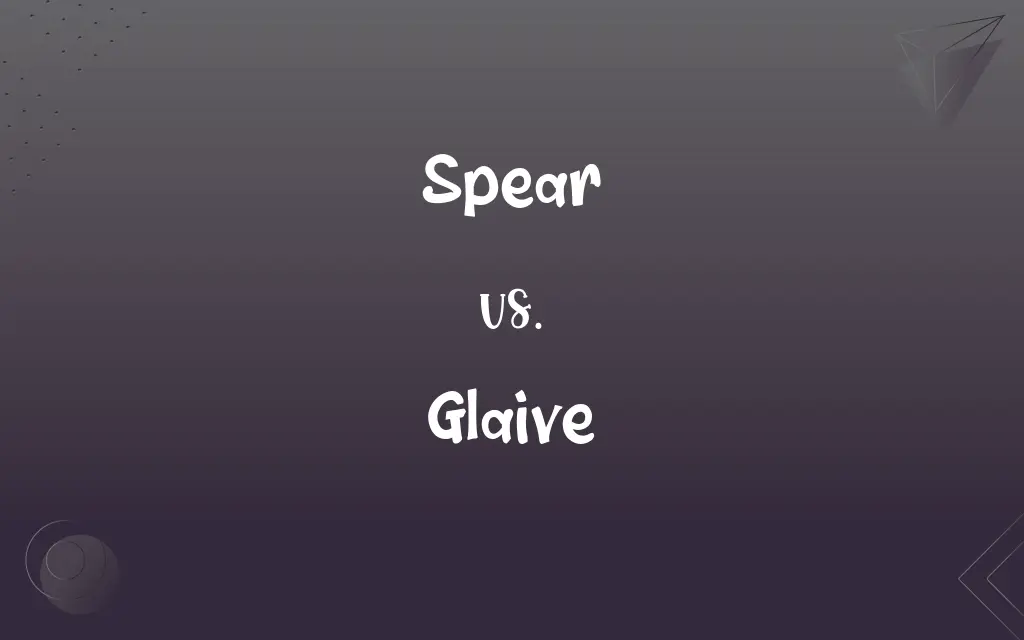Spear vs. Glaive: What's the Difference?
Edited by Harlon Moss || By Janet White || Updated on August 8, 2024
A spear is a long pole with a sharp point, typically used for thrusting, while a glaive is a polearm with a blade on the end, used for slashing and thrusting.

Key Differences
The spear and glaive are both ancient weapons, but their primary distinctions lie in design and use. A spear is designed primarily for thrusting, characterized by its pointed tip. In contrast, the glaive possesses a bladed edge, making it apt for both slashing and thrusting motions.
Historically, the spear was one of the earliest weapons adopted by primitive societies. Its simplicity—a long shaft with a sharpened end—made it versatile for hunting and combat. The glaive, however, emerged later, integrating the advantages of both the spear for thrusting and the sword for slashing.
In many ancient armies, the spear was a standard weapon for infantry due to its reach and ease of production. The glaive, on the other hand, often served elite or specialized troops, benefiting those skilled in its combined offensive techniques.
When examining the weapon's construction, a spear is often just a long shaft—wooden or metal—with a sharpened tip or affixed blade. The glaive distinguishes itself with its extended blade, reminiscent of a sword's, attached to a long pole.
In cultural representations, the spear often symbolizes simplicity, directness, and ancient warfare. In contrast, the glaive is sometimes seen as a more sophisticated or exotic weapon, often associated with skilled warriors or ceremonial purposes.
ADVERTISEMENT
Comparison Chart
Definition
A pole with a sharp point
A polearm with a blade on the end
Primary Use
Thrusting
Slashing and thrusting
Historical Prevalence
Commonly used by infantry
Used by elite or specialized troops
Construction
Long shaft with a sharpened tip or affixed blade
Extended blade on a pole, like a sword's edge
Cultural Symbolism
Simplicity, directness, ancient warfare
Sophistication, skill, ceremonial purposes
ADVERTISEMENT
Spear and Glaive Definitions
Spear
A pole with a sharp, pointed end.
The hunter used a spear to catch fish.
Glaive
An elongated blade on a pole, often with ornate designs.
The ceremonial glaive was adorned with intricate patterns.
Spear
A symbol of power or military might.
The leader held his spear high, rallying the troops.
Glaive
A symbol of elite or specialized warriors.
Only the king's guard were permitted to carry glaives.
Spear
An ancient tool for hunting and combat.
The tribe crafted spears from wood and stone.
Glaive
A weapon requiring training to use effectively.
Mastering the glaive took years of dedicated practice.
Spear
A weapon consisting of a long shaft with a sharply pointed end.
Glaive
A weapon combining features of a sword and spear.
Skilled combatants favored the glaive for its versatility.
Spear
A shaft with a sharp point and barbs for spearing fish.
Glaive
A polearm with a bladed end for slashing.
The warrior's glaive gleamed menacingly in the sunlight.
Spear
A soldier armed with a spear.
Glaive
A sword, especially a broadsword.
Spear
A slender stalk, as of asparagus.
Glaive
A light lance with a long, sharp-pointed head.
Spear
To pierce with a spear or other sharp object.
Glaive
(historical) A weapon consisting of a pole with a large blade fixed on the end, the edge of which is on the outside curve.
Spear
To catch with a thrust of the arm
Spear a grounder.
Glaive
A sword, particularly a broadsword.
Spear
(Football) To block (an opponent) by ramming with the helmet, in violation of the rules.
Glaive
A weapon formerly used, consisting of a large blade fixed on the end of a pole, whose edge was on the outside curve; also, a light lance with a long sharp-pointed head.
Spear
(Sports) To jab (an opponent) with the blade of a hockey stick, in violation of the rules.
Glaive
A sword; - used poetically and loosely.
The glaive which he did wield.
Spear
To stab at something with a spear or other sharp object.
Spear
To sprout like a spear.
Spear
A long stick with a sharp tip used as a weapon for throwing or thrusting, or anything used to make a thrusting motion.
Spear
A soldier armed with such a weapon; a spearman.
Spear
A lance with barbed prongs, used by fishermen to retrieve fish.
Spear
(ice hockey) An illegal maneuver using the end of a hockey stick to strike into another hockey player.
Spear
(wrestling) In professional wrestling, a running tackle in which the wrestler's shoulder is driven into the opponent's midsection.
Spear
A shoot, as of grass; a spire.
Spear
The feather of a horse.
Spear
The rod to which the bucket, or plunger, of a pump is attached; a pump rod.
Spear
A long, thin strip from a vegetable.
Asparagus and broccoli spears
Spear
(botany) The sprout of a plant, stalk
Spear
(obsolete) A church spire.
Spear
(transitive) To pierce with a spear.
Spear
To penetrate or strike with, or as if with, any long narrow object; to make a thrusting motion that catches an object on the tip of a long device.
Spear
(gridiron football) To tackle an opponent by ramming into them with one's helmet.
Spear
(intransitive) To shoot into a long stem, as some plants do.
Spear
To ignore as a social snub.
Spear
Male.
A spear counterpart
Spear
Pertaining to male family members.
The spear side of the family
Spear
A long, pointed weapon, used in war and hunting, by thrusting or throwing; a weapon with a long shaft and a sharp head or blade; a lance.
They shall beat their swords into plowshares, and their spears into pruning hooks.
Spear
Fig.: A spearman.
Spear
A sharp-pointed instrument with barbs, used for stabbing fish and other animals.
Spear
A shoot, as of grass; a spire.
Spear
The rod to which the bucket, or plunger, of a pump is attached; a pump rod.
Spear
To pierce with a spear; to kill with a spear; as, to spear a fish.
Spear
To shoot into a long stem, as some plants. See Spire.
Spear
A long pointed rod used as a weapon
Spear
An implement with a shaft and barbed point used for catching fish
Spear
Pierce with a spear;
Spear fish
Spear
Thrust up like a spear;
The branch speared up into the air
Spear
A long weapon used for thrusting.
He defended himself with a spear.
Spear
A weapon characterized by its long reach.
The phalanx formation utilized the spear's extended length.
FAQs
Were spears used for anything besides combat?
Yes, spears were also commonly used for hunting.
Which is older, the spear or the glaive?
The spear is older, being one of the earliest weapons used by humans.
Was the glaive used in any specific cultures?
Variants of the glaive appeared in multiple cultures, including European and Asian societies.
Is the glaive similar to any other weapons?
Yes, the glaive is similar to other polearms like the halberd or naginata.
Why was the glaive not as common as the spear?
The glaive's design made it more complex and potentially costlier to produce than the simpler spear.
Were spears used by cavalry?
Yes, cavalry often used longer spears known as lances.
Were glaives ever used for ceremonial purposes?
Yes, ornately designed glaives were sometimes used in ceremonies or as symbols of status.
Is the spear still used today?
While not common in modern warfare, spears are still used in some cultural ceremonies and for sport.
How long were typical spears?
Lengths varied, but many battle spears ranged from 6 to 8 feet.
Are there martial arts that focus on the glaive?
Yes, various martial arts incorporate glaive-like weapons, such as the Chinese guandao or Japanese naginata.
What makes the glaive different from a halberd?
While both are polearms, the glaive typically has a longer blade, while halberds often incorporate axe-like features.
How effective was the glaive against armored opponents?
The glaive's slashing capability made it effective against lighter armor, but its thrusting motion could be used against more heavily armored foes.
Could a spear be thrown?
Yes, some spears, like javelins, were specifically designed for throwing.
How were spears typically constructed?
Most spears consisted of a long wooden shaft with a metal or stone tip.
Was the glaive's blade always straight?
While many glaives had straight blades, variations with curved blades also existed.
Did glaives always have a pointed tip?
Most glaives had pointed tips to allow for thrusting, combining the features of spears and swords.
How did the spear influence military tactics?
The spear's length and thrusting ability led to formations like the phalanx, optimizing its defensive and offensive capabilities.
Can a spear be dual-tipped?
While less common, some spears had points or blades on both ends.
Were spears only used by infantry?
Primarily, but they were also adapted for use by cavalry, as in the case of lances.
What's the main tactical advantage of the glaive?
The glaive's combination of slashing and thrusting capabilities allowed for a wider range of combat techniques.
About Author
Written by
Janet WhiteJanet White has been an esteemed writer and blogger for Difference Wiki. Holding a Master's degree in Science and Medical Journalism from the prestigious Boston University, she has consistently demonstrated her expertise and passion for her field. When she's not immersed in her work, Janet relishes her time exercising, delving into a good book, and cherishing moments with friends and family.
Edited by
Harlon MossHarlon is a seasoned quality moderator and accomplished content writer for Difference Wiki. An alumnus of the prestigious University of California, he earned his degree in Computer Science. Leveraging his academic background, Harlon brings a meticulous and informed perspective to his work, ensuring content accuracy and excellence.







































































